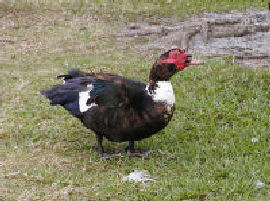Duck-like Birds
Description
The Muscovy Duck Cairina moschata is a large perching duck that breeds inland in central and tropical South America. It is a species whose normal habitat is forest lakes and streams. It is a non-migratory bird and often roosts in trees at night. Muscovy Ducks found in South Florida are a domesticated duck. Its most distinguishing feature is its bare red face, with a more pronounced caruncle at the base of the drake's bill; other distinguishing features include a low crest of feathers that it can raise on its head, long talons on its feet and a wide flat tail. The original (wild version) of this bird is black and white, but domestication has produced a variety of colors, including white, black, brown, and blue. They have large red warty caruncles around the base of the bill and around the eye. Their feet can vary in color from bright orange to black. They have strong, sharp claws on their feet. The black and white birds may have a green-blue irridesence on the black feathers. 25-34" in length.
Range
Breeds inland in central and tropical South America. Widely domesticated in Europe and North America.
Voice
The drake has a dry hissing call, and the hen a quiet trilling coo.
Discussion
This species is widely domesticated and then known as Barbary Duck. This breed is popular because it has stronger-tasting meat, like roast beef, and is less noisy. The carcass of a muscovy duck is also much heavier than most other types of ducks, which make them ideal for the dinner table. Wild birds are all-dark apart from the white in the wings, but domesticated birds, like those pictured, often have other plumage features. They are usually also bulkier than the wild birds. Muscovy hens range from 5 to 10 pounds (2 to 5 kg), while drakes are commonly 10 to 15 pounds (5 to 7 kg). Domesticated birds have re-escaped into the wild and now breed outside the native domain, including western Europe and the United States. It can be crossed with the domestic duck in captivity to produce hybrids which are known as Mulard Duck ("mule duck" because they are sterile) and are often used in the production of foie gras.




